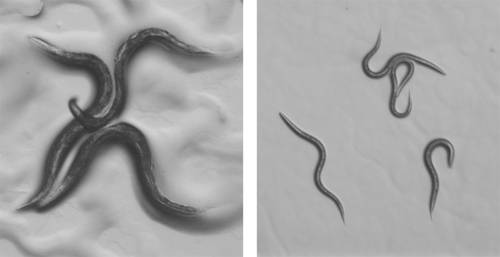
Reproducing worms (left) and dauer larvae (right).
Larvae of the nematode C.elegans can enter a stage of arrested development – called the dauer stage – in order to survive harsh conditions like heat or extreme desiccation. Researchers of the MPI-CBG now show that the developmental transition from growth and reproduction to the dauer state is not only triggered by environmental factors, but is determined by the internal metabolic state of the organism. With a high level of a certain hormone (dafachronic acid), the worm will stay in a reproductive mode, whereas its development will pause and switch to the dauer state if the amount of the hormone decreases. The worm senses the energetic status of the carbohydrate and redox metabolic pathways to take this developmental decision.
Further studies will investigate if further basic biochemical processes regulate the developmental switch of the nematode and test this also in other organisms.
Sider Penkov, Damla Kaptan, Cihan Erkut, Mihail Sarov, Fanny Mende & Teymuras V. Kurzchalia: Integration of carbohydrate metabolism and redox state controls dauer larva formation in Caenorhabditis elegans. Nature Communications, 20 August 2015